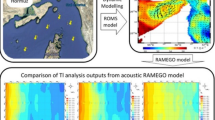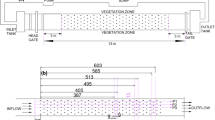Abstract
A model is presented, which describes the daily variations in suspended particulate inorganic matter (SPIM) in a large (61 km2), shallow (mean depth 3.4 m) wind-exposed lake basin at the western end of Lake Mälaren, Sweden. Field studies have shown that wind speed and river inflow are the two major factors leading to changes in SPIM. Wind speed and beam attenuation were measured at high (10 min) frequency, while river inflow were monitored at daily frequency to develop the model. From these field measurements, model-coefficients were determined for the SPIM transport, settling and resuspension. Large-scale variations in SPIM lasting many weeks could be explained by events of high river inflow with a correspondingly high particle load. The threshold for river transported SPIM to have effect on lake concentration was 150 m3 s−1, while wind induced resuspended SPIM was related to the square root of wind speed.
Similar content being viewed by others
References
http://www.avf.u.se/, 2002-09-10, Arbogaåns Vattenförbund.
http://info1.ma.slu.se/, 2000-02-02, Department for environmental assessment SLU.
Bailey, M. C. & D. P. Hamilton, 1997. Wind induced sediment resuspension: a lake-wide model. Ecol. Model. 99: 217-228.
Bartz, R., J. R. V. Zaneveld & H. Pak, 1978. A transmissometer for profiling and moored observations in water. Proceedings The International Society for Optical Engineering SPIE 160 Ocean Optics V: 102-108.
Bloesch, J., 1994. A review of methods used to measure sediment resuspension. Hydrobiologia 284: 13-18.
Blom, G., E. H. S. Vanduin & L. Lijklema, 1994. Sediment resuspension and light conditions in some shallow Dutch lakes. Water Sci. Technol. 30: 243-252.
Hagatun, K. & K. J. Eidsvik, 1986. Oscillating turbulent boundarylayer with suspended sediments. J. Geophys. Res.-Oceans 91: 3045-3055.
Hamilton, D. P. & S. F. Mitchell, 1996. An empirical model for sediment resuspension in shallow lakes. Hydrobiologia 317: 209-220.
Hawley, N. & B. M. Lesht, 1992. Sediment resuspension in Lake St-Clair. Limnol. Oceanogr. 37: 1720-1737.
Håkanson, L., 1979. Mälarens Skärgård: en Öinventering. Statens naturvårdsverk, Solna: 87 pp. Håkanson, L. & M. Jansson, 1983. Principles of Lake Sedimentology. Springer, Berlin. 316 pp.
Ji, Z. G., J. H. Hamrick & J. Pagenkopf, 2002. Sediment and metals modeling in shallow river. J. Environ. Eng.-ASCE 128: 105-119.
Kristensen, P., M. Sondergaard & E. Jeppesen, 1992. Resuspension in a shallow eutrophic lake. Hydrobiologia 228: 101-109.
Lou, J., D. J. Schwab, D. Beletsky & N. Hawley, 2000. A model of sediment resuspension and transport dynamics in southern Lake Michigan. J. Geophys. Res.-Oceans 105: 6591-6610.
Luettich, R. A., D. R. F. Harleman & L. Somlyody, 1990. Dynamic behavior of suspended sediment concentrations in a shallow lake perturbed by episodic wind events. Limnol. Oceanogr. 35: 1050- 1067.
Pierson, D. C., H. Markensten & N. Strömbeck, 2003. Long and short term variations in suspended particulate material: the influence on light available to the phytoplankton community. Hydrobiologia 494 (Dev. Hydrobiol. 169): 299-304.
Pierson, D. C. & G. A. Weyhenmeyer, 1994. High-resolution measurements of sediment resuspension above an accumulation bottom in a stratified lake. Hydrobiologia 284: 43-57.
Somlyody, L. & L. Koncsos, 1991. Influence of sediment resuspension on the light conditions and algal growth in Lake Balaton. Ecol. Model. 57: 173-192.
Teeter, A. M., B. H. Johnson, C. Berger, G. Stelling, N. W. Scheffner, M. H. Garcia & T. M. Parchure, 2001. Hydrodynamic and sediment transport modeling with emphasis on shallowwater, vegetated areas (lakes, reservoirs, estuaries and lagoons). Hydrobiologia 444: 1-24.
Tsanis, I. K., K. L. Prescott & H. Shen, 1998. Modelling of phosphorus and suspended solids in Cootes Paradise marsh. Ecol. Model. 114: 1-17.
Author information
Authors and Affiliations
Rights and permissions
About this article
Cite this article
Markensten, H., Pierson, D.C. A dynamic model for flow and wind driven sediment resuspension in a shallow basin. Hydrobiologia 494, 305–311 (2003). https://doi.org/10.1023/A:1025459525880
Issue Date:
DOI: https://doi.org/10.1023/A:1025459525880




